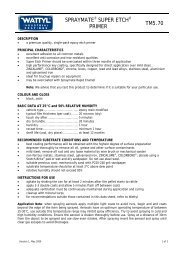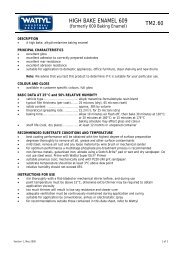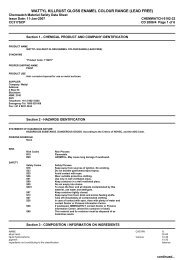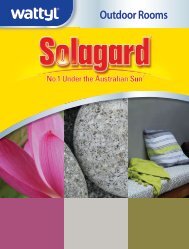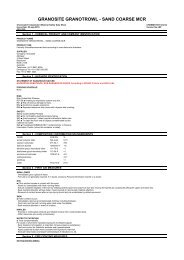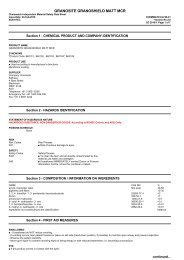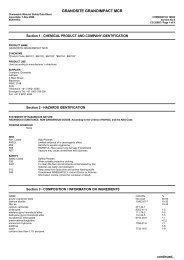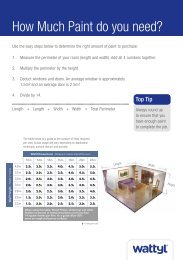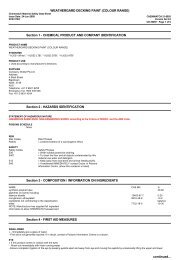Chemwatch Australian MSDS 02-0053 - Wattyl
Chemwatch Australian MSDS 02-0053 - Wattyl
Chemwatch Australian MSDS 02-0053 - Wattyl
You also want an ePaper? Increase the reach of your titles
YUMPU automatically turns print PDFs into web optimized ePapers that Google loves.
GRANOSITE GRANOMATT MEMBRANE MCR<br />
<strong>Chemwatch</strong> Material Safety Data Sheet<br />
Issue Date: 7-Nov-2008 CHEMWATCH <strong>02</strong>-<strong>0053</strong><br />
XC9317EC<br />
Version No:3<br />
CD 2008/3 Page 1 of 8<br />
Section 1 - CHEMICAL PRODUCT AND COMPANY IDENTIFICATION<br />
PRODUCT NAME<br />
GRANOSITE GRANOMATT MEMBRANE MCR<br />
SYNONYMS<br />
"Product Code: 861301"<br />
PRODUCT USE<br />
Used according to manufacturer' s directions. Membrane coating.<br />
SUPPLIER<br />
Company: Granosite<br />
Address:<br />
4 Steel Street<br />
Blacktown<br />
NSW, 2148<br />
AUS<br />
Telephone: +61 2 9621 6255<br />
Emergency Tel: +61 1800 039 008<br />
Fax: +61 2 9831 4244<br />
Section 2 - HAZARDS IDENTIFICATION<br />
STATEMENT OF HAZARDOUS NATURE<br />
HAZARDOUS SUBSTANCE. NON-DANGEROUS GOODS. According to the Criteria of NOHSC, and the ADG Code.<br />
POISONS SCHEDULE<br />
None<br />
RISK<br />
Risk Codes<br />
R40(3)<br />
SAFETY<br />
Safety Codes<br />
S36<br />
S401<br />
S13<br />
S46<br />
Risk Phrases<br />
Limited evidence of a carcinogenic effect.<br />
Safety Phrases<br />
Wear suitable protective clothing.<br />
To clean the floor and all objects contaminated by this<br />
material use water and detergent.<br />
Keep away from food drink and animal feeding stuffs.<br />
If swallowed IMMEDIATELY contact Doctor or Poisons<br />
Information Centre. (show this container or label).<br />
Section 3 - COMPOSITION / INFORMATION ON INGREDIENTS<br />
NAME CAS RN %<br />
acrylic copolymer latex Not avail. 30-60<br />
calcium carbonate 471-34-1
GRANOSITE GRANOMATT MEMBRANE MCR<br />
<strong>Chemwatch</strong> Material Safety Data Sheet<br />
Issue Date: 7-Nov-2008 CHEMWATCH <strong>02</strong>-<strong>0053</strong><br />
XC9317EC<br />
Version No:3<br />
CD 2008/3 Page 2 of 8<br />
Section 4 - FIRST AID MEASURES<br />
• Wash out immediately with fresh running water.<br />
• Ensure complete irrigation of the eye by keeping eyelids apart and away from eye and moving the eyelids by occasionally lifting the upper and lower lids.<br />
• If pain persists or recurs seek medical attention.<br />
• Removal of contact lenses after an eye injury should only be undertaken by skilled personnel.<br />
SKIN<br />
If skin or hair contact occurs:<br />
• Flush skin and hair with running water (and soap if available).<br />
• Seek medical attention in event of irritation.<br />
INHALED<br />
• If fumes or combustion products are inhaled remove from contaminated area.<br />
• Other measures are usually unnecessary.<br />
NOTES TO PHYSICIAN<br />
Treat symptomatically.<br />
Section 5 - FIRE FIGHTING MEASURES<br />
EXTINGUISHING MEDIA<br />
• There is no restriction on the type of extinguisher which may be used.<br />
• Use extinguishing media suitable for surrounding area.<br />
FIRE FIGHTING<br />
• Alert Fire Brigade and tell them location and nature of hazard.<br />
• Wear breathing apparatus plus protective gloves for fire only.<br />
• Prevent, by any means available, spillage from entering drains or water courses.<br />
• Use fire fighting procedures suitable for surrounding area.<br />
FIRE/EXPLOSION HAZARD<br />
• Non combustible.<br />
• Not considered a significant fire risk, however containers may burn., carbon dioxide (CO2), nitrogen oxides (NOx), other<br />
pyrolysis products typical of burning organic material.<br />
FIRE INCOMPATIBILITY<br />
• Avoid contamination with oxidising agents i.e. nitrates, oxidising acids, chlorine bleaches, pool chlorine etc. as ignition may<br />
result.<br />
HAZCHEM: None<br />
Section 6 - ACCIDENTAL RELEASE MEASURES<br />
EMERGENCY PROCEDURES<br />
MINOR SPILLS<br />
• Clean up all spills immediately.<br />
• Avoid breathing vapours and contact with skin and eyes.<br />
• Control personal contact by using protective equipment.<br />
• Contain and absorb spill with sand, earth, inert material or vermiculite.<br />
MAJOR SPILLS<br />
Moderate hazard.<br />
• Clear area of personnel and move upwind.<br />
• Alert Fire Brigade and tell them location and nature of hazard.<br />
• Wear breathing apparatus plus protective gloves.<br />
• Prevent, by any means available, spillage from entering drains or water course.<br />
Personal Protective Equipment advice is contained in Section 8 of the <strong>MSDS</strong>.<br />
Section 7 - HANDLING AND STORAGE<br />
PROCEDURE FOR HANDLING<br />
• Avoid all personal contact, including inhalation.<br />
• Wear protective clothing when risk of exposure occurs.<br />
• Use in a well-ventilated area.<br />
• Avoid contact with moisture.<br />
SUITABLE CONTAINER<br />
• Polyethylene or polypropylene container.<br />
• Packing as recommended by manufacturer.<br />
• Check all containers are clearly labelled and free from leaks.<br />
continued...
GRANOSITE GRANOMATT MEMBRANE MCR<br />
<strong>Chemwatch</strong> Material Safety Data Sheet<br />
Issue Date: 7-Nov-2008 CHEMWATCH <strong>02</strong>-<strong>0053</strong><br />
XC9317EC<br />
Version No:3<br />
CD 2008/3 Page 3 of 8<br />
Section 7 - HANDLING AND STORAGE<br />
STORAGE INCOMPATIBILITY<br />
• Avoid reaction with oxidising agents.<br />
STORAGE REQUIREMENTS<br />
• Store in original containers.<br />
• Keep containers securely sealed.<br />
• Store in a cool, dry, well-ventilated area.<br />
• Store away from incompatible materials and foodstuff containers.<br />
Section 8 - EXPOSURE CONTROLS / PERSONAL PROTECTION<br />
EXPOSURE CONTROLS<br />
Source Material TWA ppm TWA mg/m³ STEL ppm STEL mg/m³<br />
__________________ __________________ _______ _______ _______ _______<br />
Australia Exposure calcium carbonate 10<br />
Standards<br />
(Calcium carbonate (a))<br />
Australia Exposure titanium dioxide 10<br />
Standards<br />
(Titanium dioxide (a))<br />
Australia Exposure diuron (Diuron) 10<br />
Standards<br />
Australia Exposure ammonium hydroxide 25 17 35 24<br />
Standards<br />
(Ammonia)<br />
The following materials had no OELs on our records<br />
• 2, 2, 4- trimethyl- 1, 3- pentanediol CAS:25265- 77- 4 CAS:77- 68- 9<br />
monoisobutyrate:<br />
• 2- octyl- 4- isothiazolin- 3- one: CAS:26530- 20- 1<br />
• 1, 2- benzisothiazoline- 3- one: CAS:2634- 33- 5<br />
• 2- methyl- 4- isothiazolin- 3- one: CAS:2682- 20- 4<br />
PERSONAL PROTECTION<br />
RESPIRATOR<br />
Type AK-P Filter of sufficient capacity<br />
EYE<br />
• Safety glasses with side shields.<br />
• Chemical goggles.<br />
• Contact lenses may pose a special hazard; soft contact lenses may absorb and concentrate irritants. A written policy document,<br />
describing the wearing of lens or restrictions on use, should be created for each workplace or task. This should include a review<br />
of lens absorption and adsorption for the class of chemicals in use and an account of injury experience. Medical and first-aid<br />
personnel should be trained in their removal and suitable equipment should be readily available. In the event of chemical<br />
exposure, begin eye irrigation immediately and remove contact lens as soon as practicable. Lens should be removed at the first<br />
signs of eye redness or irritation - lens should be removed in a clean environment only after workers have washed hands<br />
thoroughly. [CDC NIOSH Current Intelligence Bulletin 59].<br />
HANDS/FEET<br />
Suitability and durability of glove type is dependent on usage. Factors such as:<br />
• frequency and duration of contact,<br />
• chemical resistance of glove material,<br />
• glove thickness and<br />
• dexterity,.<br />
• Wear chemical protective gloves, eg. PVC.<br />
• Wear safety footwear or safety gumboots, eg. Rubber.<br />
OTHER<br />
• Overalls.<br />
• P.V.C. apron.<br />
• Barrier cream.<br />
• Skin cleansing cream.<br />
ENGINEERING CONTROLS<br />
General exhaust is adequate under normal operating conditions. Local exhaust ventilation may be required in specific<br />
circumstances.<br />
Section 9 - PHYSICAL AND CHEMICAL PROPERTIES<br />
APPEARANCE<br />
White liquid with a characteristic odour; miscible with water.<br />
PHYSICAL PROPERTIES<br />
Liquid.<br />
Mixes with water.<br />
continued...
GRANOSITE GRANOMATT MEMBRANE MCR<br />
<strong>Chemwatch</strong> Material Safety Data Sheet<br />
Issue Date: 7-Nov-2008 CHEMWATCH <strong>02</strong>-<strong>0053</strong><br />
XC9317EC<br />
Version No:3<br />
CD 2008/3 Page 4 of 8<br />
Section 9 - PHYSICAL AND CHEMICAL PROPERTIES<br />
Molecular Weight: Not Available<br />
Boiling Range (°C): 100 aprox<br />
Melting Range (°C): Not Available Specific Gravity (water=1): >1<br />
Solubility in water (g/L): Miscible pH (as supplied): 10<br />
pH (1% solution): Not Available<br />
Vapour Pressure (kPa): Not Available<br />
Volatile Component (%vol): Not Available<br />
Evaporation Rate: Not Available<br />
Relative Vapour Density (air=1): Not<br />
Flash Point (°C): Not Applicable<br />
Available<br />
Lower Explosive Limit (%): Not Applicable<br />
Upper Explosive Limit (%): Not Applicable<br />
Autoignition Temp (°C): Not Applicable<br />
Decomposition Temp (°C): Not Available<br />
State: Liquid<br />
Viscosity: Not Available<br />
Section 10 - CHEMICAL STABILITY AND REACTIVITY INFORMATION<br />
CONDITIONS CONTRIBUTING TO INSTABILITY<br />
• Presence of incompatible materials.<br />
• Product is considered stable.<br />
• Hazardous polymerisation will not occur.<br />
For incompatible materials - refer to Section 7 - Handling and Storage.<br />
Section 11 - TOXICOLOGICAL INFORMATION<br />
POTENTIAL HEALTH EFFECTS<br />
ACUTE HEALTH EFFECTS<br />
Not applicable.<br />
CHRONIC HEALTH EFFECTS<br />
Limited evidence of a carcinogenic effect.<br />
TOXICITY AND IRRITATION<br />
Not available. Refer to individual constituents.<br />
ACRYLIC COPOLYMER LATEX:<br />
No significant acute toxicological data identified in literature search.<br />
CALCIUM CARBONATE:<br />
unless otherwise specified data extracted from RTECS - Register of Toxic Effects of Chemical Substances.<br />
TOXICITY<br />
Oral (Rat) LD50: 6450 mg/kg<br />
IRRITATION<br />
Skin (rabbit): 500 mg/24h- Moderate<br />
Eye (rabbit): 0.75 mg/24h - SEVERE<br />
The material may produce severe irritation to the eye causing pronounced inflammation. Repeated or prolonged exposure to irritants may produce<br />
conjunctivitis.<br />
The material may cause skin irritation after prolonged or repeated exposure and may produce a contact dermatitis (nonallergic). This form of dermatitis is<br />
often characterised by skin redness (erythema) and swelling the epidermis.<br />
No evidence of carcinogenic properties.<br />
teratogenic effects.<br />
No evidence of mutagenic or<br />
TITANIUM DIOXIDE:<br />
unless otherwise specified data extracted from RTECS - Register of Toxic Effects of Chemical Substances.<br />
TOXICITY<br />
IRRITATION<br />
Oral (Rat) LD50: >20000 mg/kg * Skin (human): 0.3 mg /3D (int)- Mild *<br />
Oral (Mouse) LD50: >10000 mg/kg *<br />
The material may produce moderate eye irritation leading to inflammation. Repeated or prolonged exposure to irritants may produce conjunctivitis.<br />
The material may cause skin irritation after prolonged or repeated exposure and may produce a contact dermatitis (nonallergic). This form of dermatitis is<br />
often characterised by skin redness (erythema) and swelling epidermis.<br />
For titanium dioxide:<br />
Humans can be exposed to titanium dioxide via inhalation, ingestion or dermal contact. In human lungs, the clearance kinetics of titanium dioxide is poorly<br />
characterized relative to that in experimental animals.<br />
* IUCLID<br />
2,2,4-TRIMETHYL-1,3-PENTANEDIOL MONOISOBUTYRATE:<br />
unless otherwise specified data extracted from RTECS - Register of Toxic Effects of Chemical Substances.<br />
TOXICITY<br />
IRRITATION<br />
Oral (rat) LD50: 3200 mg/kg Skin - Slight Irritant *<br />
Oral (rat) LD50: 3200 mg/kg *** Skin (rabbit): Mild ***<br />
Dermal (rabbit) LD50: >16 ml/kg * Eyes - Moderate Irritant *<br />
Dermal (g.pig) LD50: >16 ml/kg ***<br />
Inhalation (rat) LC50: >3.55 mg/l/6h<br />
Inhalation (rat) LC50: 1600 mg/kg ***<br />
Oral (Mouse) LD50: 3200 mg/kg<br />
Dermal (Guinea) pig: LD50>20 ml/kg<br />
The material may be irritating to the eye, with prolonged contact causing inflammation. Repeated or prolonged exposure to irritants may produce<br />
conjunctivitis.<br />
The material may cause skin irritation after prolonged or repeated exposure and may produce a contact dermatitis (nonallergic). This form of dermatitis is<br />
often characterised by skin redness (erythema) and swelling epidermis.<br />
Not a skin sensitiser (guinea pig, Magnusson-Kligman) ***<br />
Ames Test: negative ***<br />
continued...
GRANOSITE GRANOMATT MEMBRANE MCR<br />
<strong>Chemwatch</strong> Material Safety Data Sheet<br />
Issue Date: 7-Nov-2008 CHEMWATCH <strong>02</strong>-<strong>0053</strong><br />
XC9317EC<br />
Version No:3<br />
CD 2008/3 Page 5 of 8<br />
Section 11 - TOXICOLOGICAL INFORMATION<br />
Micronucleus, mouse: negative ***<br />
Not mutagenic ***<br />
No effects on fertility or foetal development seen in the rat ***<br />
* [SWIFT]<br />
** [Eastman]<br />
*** [Perstop]<br />
DIURON:<br />
unless otherwise specified data extracted from RTECS - Register of Toxic Effects of Chemical Substances.<br />
TOXICITY<br />
IRRITATION<br />
Oral (rat) LD50: 1017 mg/kg<br />
Nil Reported<br />
Dermal (rat) LD50: >5000 mg/kg<br />
Diuron is absorbed readily through the gut and lungs while uptake through the skin is more limited. It is slightly toxic to mammals but juveniles are more<br />
susceptible than adults(18).<br />
Note: Equivocal animal tumorigenic agent by RTECS criteria.<br />
NOTE: This substance may contain impurities (tetrachlorazobenzene and<br />
tetrachloroazoxybenzene).<br />
Maximum impurity levels are proscribed under various jurisdictions<br />
ADI: 0.006 mg/kg/day<br />
NOEL: 0.625 mg/kg/day<br />
AMMONIUM HYDROXIDE:<br />
unless otherwise specified data extracted from RTECS - Register of Toxic Effects of Chemical Substances.<br />
TOXICITY<br />
IRRITATION<br />
Oral (rat) LD50: 350 mg/kg<br />
Eye (rabbit): 0.25 mg SEVERE<br />
Oral (human) LDLo: 43 mg/kg<br />
Eye (rabbit): 1 mg/30s SEVERE<br />
Inhalation (human) LCLo: 5000 ppm/5m<br />
Inhalation (human) TCLo: 20 ppm<br />
Inhalation (rat) LC50: 2000 ppm/4h<br />
Unreported (man) LDLo: 132 mg/kg<br />
The material may produce severe irritation to the eye causing pronounced inflammation. Repeated or prolonged exposure to irritants may produce<br />
conjunctivitis.<br />
Asthma-like symptoms may continue for months or even years after exposure to the material ceases. This may be due to a non-allergenic condition known as<br />
reactive airways dysfunction syndrome (RADS) which can occur following exposure to high levels of highly irritating compound.<br />
2-OCTYL-4-ISOTHIAZOLIN-3-ONE:<br />
unless otherwise specified data extracted from RTECS - Register of Toxic Effects of Chemical Substances.<br />
TOXICITY<br />
Oral (rat) LD50: 550 mg/kg<br />
Dermal (rabbit) LD50: 690 mg/kg<br />
Oral (male) rat: LD50 248 mg/kg<br />
Oral (female) rat: LD50 293 mg/kg<br />
Dermal (male) rabbit: LD50 311 mg/kg<br />
IRRITATION<br />
Skin (rabbit): 500 mg/24 hours<br />
Eye(rabbit):100 mg SEVERE<br />
Skin (rabbit): 45% conc SEVERE<br />
Eye (rabbit): 45% conc CORROSIVE<br />
Eye (rabbit): 5% conc Moderate<br />
Eye (rabbit): 0.5% non Irritant<br />
Contact allergies quickly manifest themselves as contact eczema, more rarely as urticaria or Quincke's oedema. The pathogenesis of contact eczema involves<br />
a cell-mediated (T lymphocytes) immune reaction of the delayed type.<br />
Asthma-like symptoms may continue for months or even years after exposure to the material ceases. This may be due to a non-allergenic condition known as<br />
reactive airways dysfunction syndrome (RADS) which can occur following exposure to high levels of highly irritating compound.<br />
ROHM & HAAS Data<br />
ADI: 0.03 mg/kg/day<br />
NOEL: 60 mg/kg/day<br />
1,2-BENZISOTHIAZOLINE-3-ONE:<br />
unless otherwise specified data extracted from RTECS - Register of Toxic Effects of Chemical Substances.<br />
TOXICITY<br />
IRRITATION<br />
Oral (rat) LD50: 1<strong>02</strong>0 mg/kg<br />
Nil Reported<br />
Contact allergies quickly manifest themselves as contact eczema, more rarely as urticaria or Quincke's oedema. The pathogenesis of contact eczema involves<br />
a cell-mediated (T lymphocytes) immune reaction of the delayed type.<br />
Oral (rat) LD50: 670 mg/kg (male)*<br />
Oral (rat) LD50: 784 mg/kg (female) *<br />
*MAK Documentation<br />
2-METHYL-4-ISOTHIAZOLIN-3-ONE:<br />
Contact allergies quickly manifest themselves as contact eczema, more rarely as urticaria or Quincke's oedema. The pathogenesis of contact eczema involves<br />
a cell-mediated (T lymphocytes) immune reaction of the delayed type.<br />
The material may be irritating to the eye, with prolonged contact causing inflammation. Repeated or prolonged exposure to irritants may produce<br />
conjunctivitis.<br />
The material may cause skin irritation after prolonged or repeated exposure and may produce a contact dermatitis (nonallergic). This form of dermatitis is<br />
often characterised by skin redness (erythema) and swelling epidermis.<br />
Asthma-like symptoms may continue for months or even years after exposure to the material ceases. This may be due to a non-allergenic condition known as<br />
reactive airways dysfunction syndrome (RADS) which can occur following exposure to high levels of highly irritating compound.<br />
No significant acute toxicological data identified in literature search.<br />
NOTE: Substance has been shown to be mutagenic in at least one assay, or belongs to a family of chemicals producing damage or change to cellular DNA.<br />
Considered to be a minor sensitiser in Kathon CG (1)<br />
(1). Bruze etal - Contact Dermatitis 20: 219-39, 1989<br />
MATERIAL CARCINOGEN REPROTOXIN SENSITISER SKIN<br />
_______________ ____________ __________ __________ __________<br />
titanium dioxide<br />
IARC:2B<br />
continued...
GRANOSITE GRANOMATT MEMBRANE MCR<br />
<strong>Chemwatch</strong> Material Safety Data Sheet<br />
Issue Date: 7-Nov-2008 CHEMWATCH <strong>02</strong>-<strong>0053</strong><br />
XC9317EC<br />
Version No:3<br />
CD 2008/3 Page 6 of 8<br />
Section 11 - TOXICOLOGICAL INFORMATION<br />
CARCINOGEN<br />
IARC: International Agency for Research on Cancer (IARC) Carcinogens: titanium dioxide Category: WARNING: This substance has<br />
been classified by the IARC as Group 2B: Possibly Carcinogenic to Humans.<br />
No data<br />
Section 12 - ECOLOGICAL INFORMATION<br />
Section 13 - DISPOSAL CONSIDERATIONS<br />
• Containers may still present a chemical hazard/ danger when empty.<br />
• Return to supplier for reuse/ recycling if possible.<br />
Otherwise:<br />
• If container can not be cleaned sufficiently well to ensure that residuals do not remain or if the container cannot be used to<br />
store the same product, then puncture containers, to prevent re-use, and bury at an authorised landfill.<br />
• Where possible retain label warnings and <strong>MSDS</strong> and observe all notices pertaining to the product.<br />
• Recycle wherever possible.<br />
• Consult manufacturer for recycling options or consult local or regional waste management authority for disposal if no suitable<br />
treatment or disposal facility can be identified.<br />
• Dispose of by: Burial in a licenced land-fill or incineration in a licenced apparatus (after admixture with suitable<br />
combustible material).<br />
• Decontaminate empty containers. Observe all label safeguards until containers are cleaned and destroyed.<br />
HAZCHEM: None (ADG6)<br />
Section 14 - TRANSPORTATION INFORMATION<br />
NOT REGULATED FOR TRANSPORT OF DANGEROUS GOODS: UN, IATA, IMDG<br />
Section 15 - REGULATORY INFORMATION<br />
POISONS SCHEDULE: None<br />
REGULATIONS<br />
Granosite Granomatt Membrane MCR (CAS: None):<br />
No regulations applicable<br />
calcium carbonate (CAS: 471-34-1) is found on the following regulatory lists;<br />
Australia High Volume Industrial Chemical List (HVICL)<br />
Australia Inventory of Chemical Substances (AICS)<br />
Australia Therapeutic Goods Administration (TGA) Substances that may be used as active ingredients in Listed medicines<br />
CODEX General Standard for Food Additives (GSFA) - Additives Permitted for Use in Food in General, Unless Otherwise Specified, in Accordance with GMP<br />
GESAMP/EHS Composite List of Hazard Profiles - Hazard evaluation of substances transported by ships<br />
IMO IBC Code Chapter 17: Summary of minimum requirements<br />
International Council of Chemical Associations (ICCA) - High Production Volume List<br />
OECD Representative List of High Production Volume (HPV) Chemicals<br />
calcium carbonate (CAS: 1317-65-3) is found on the following regulatory lists;<br />
Australia Exposure Standards<br />
Australia Inventory of Chemical Substances (AICS)<br />
Australia Standard for the Uniform Scheduling of Drugs and Poisons (SUSDP) - Schedule 6<br />
OECD Representative List of High Production Volume (HPV) Chemicals<br />
titanium dioxide (CAS: 13463-67-7) is found on the following regulatory lists;<br />
Australia Exposure Standards<br />
Australia High Volume Industrial Chemical List (HVICL)<br />
Australia Inventory of Chemical Substances (AICS)<br />
Australia Standard for the Uniform Scheduling of Drugs and Poisons (SUSDP) - Schedule 4<br />
Australia Standard for the Uniform Scheduling of Drugs and Poisons (SUSDP) - Schedule 5<br />
Australia Therapeutic Goods Administration (TGA) Substances that may be used as active ingredients in Listed medicines<br />
Australia Therapeutic Goods Administration (TGA) Sunscreening agents permitted as active ingredients in listed products<br />
CODEX General Standard for Food Additives (GSFA) - Additives Permitted for Use in Food in General, Unless Otherwise Specified, in Accordance with GMP<br />
IMO IBC Code Chapter 17: Summary of minimum requirements<br />
International Agency for Research on Cancer (IARC) Carcinogens<br />
OECD Representative List of High Production Volume (HPV) Chemicals<br />
titanium dioxide (CAS: 1317-70-0) is found on the following regulatory lists;<br />
Australia Inventory of Chemical Substances (AICS)<br />
OECD Representative List of High Production Volume (HPV) Chemicals<br />
titanium dioxide (CAS: 1317-80-2) is found on the following regulatory lists;<br />
Australia Inventory of Chemical Substances (AICS)<br />
Australia Standard for the Uniform Scheduling of Drugs and Poisons (SUSDP) - Schedule 4<br />
Australia Standard for the Uniform Scheduling of Drugs and Poisons (SUSDP) - Schedule 5<br />
GESAMP/EHS Composite List of Hazard Profiles - Hazard evaluation of substances transported by ships<br />
OECD Representative List of High Production Volume (HPV) Chemicals<br />
continued...
GRANOSITE GRANOMATT MEMBRANE MCR<br />
<strong>Chemwatch</strong> Material Safety Data Sheet<br />
Issue Date: 7-Nov-2008 CHEMWATCH <strong>02</strong>-<strong>0053</strong><br />
XC9317EC<br />
Version No:3<br />
CD 2008/3 Page 7 of 8<br />
Section 15 - REGULATORY INFORMATION<br />
titanium dioxide (CAS: 1309-63-3) is found on the following regulatory lists;<br />
Australia Standard for the Uniform Scheduling of Drugs and Poisons (SUSDP) - Schedule 4<br />
Australia Standard for the Uniform Scheduling of Drugs and Poisons (SUSDP) - Schedule 5<br />
titanium dioxide (CAS: 62338-64-1) is found on the following regulatory lists;<br />
Australia Standard for the Uniform Scheduling of Drugs and Poisons (SUSDP) - Schedule 4<br />
Australia Standard for the Uniform Scheduling of Drugs and Poisons (SUSDP) - Schedule 5<br />
2,2,4-trimethyl-1,3-pentanediol monoisobutyrate (CAS: 25265-77-4) is found on the following regulatory lists;<br />
Australia High Volume Industrial Chemical List (HVICL)<br />
Australia Inventory of Chemical Substances (AICS)<br />
GESAMP/EHS Composite List of Hazard Profiles - Hazard evaluation of substances transported by ships<br />
IMO IBC Code Chapter 17: Summary of minimum requirements<br />
IMO MARPOL 73/78 (Annex II) - List of Noxious Liquid Substances Carried in Bulk<br />
OECD Representative List of High Production Volume (HPV) Chemicals<br />
2,2,4-trimethyl-1,3-pentanediol monoisobutyrate (CAS: 77-68-9) is found on the following regulatory lists;<br />
Australia Inventory of Chemical Substances (AICS)<br />
diuron (CAS: 330-54-1) is found on the following regulatory lists;<br />
Australia - <strong>Australian</strong> Capital Territory - Environment Protection Regulation: Ambient environmental standards (Domestic water supply - pesticides)<br />
Australia - <strong>Australian</strong> Capital Territory Environment Protection Regulation Pollutants entering waterways - Domestic water quality<br />
Australia Exposure Standards<br />
Australia Hazardous Substances<br />
Australia Inventory of Chemical Substances (AICS)<br />
Australia New Zealand Food Standards Code - Maximum Residue Limits (Australia only) - Schedule 3 - Chemical Groups<br />
Australia Standard for the Uniform Scheduling of Drugs and Poisons (SUSDP) - Schedule 5<br />
Australia Standard for the Uniform Scheduling of Drugs and Poisons (SUSDP) - Schedule 6<br />
OECD Representative List of High Production Volume (HPV) Chemicals<br />
ammonium hydroxide (CAS: 1336-21-6) is found on the following regulatory lists;<br />
Australia - <strong>Australian</strong> Capital Territory - Environment Protection Regulation: Pollutants entering waterways taken to cause environmental harm (Aquatic<br />
habitat)<br />
Australia - <strong>Australian</strong> Capital Territory Environment Protection Regulation Pollutants entering waterways - Domestic water quality<br />
Australia - Queensland Hazardous Materials and Prescribed Quantities for Major Hazard Facilities<br />
Australia Exposure Standards<br />
Australia Hazardous Substances<br />
Australia High Volume Industrial Chemical List (HVICL)<br />
Australia Inventory of Chemical Substances (AICS)<br />
Australia Standard for the Uniform Scheduling of Drugs and Poisons (SUSDP) - Appendix E (Part 2)<br />
Australia Standard for the Uniform Scheduling of Drugs and Poisons (SUSDP) - Appendix F (Part 3)<br />
Australia Standard for the Uniform Scheduling of Drugs and Poisons (SUSDP) - Schedule 2<br />
Australia Standard for the Uniform Scheduling of Drugs and Poisons (SUSDP) - Schedule 5<br />
Australia Standard for the Uniform Scheduling of Drugs and Poisons (SUSDP) - Schedule 6<br />
CODEX General Standard for Food Additives (GSFA) - Additives Permitted for Use in Food in General, Unless Otherwise Specified, in Accordance with GMP<br />
GESAMP/EHS Composite List of Hazard Profiles - Hazard evaluation of substances transported by ships<br />
IMO IBC Code Chapter 17: Summary of minimum requirements<br />
IMO MARPOL 73/78 (Annex II) - List of Noxious Liquid Substances Carried in Bulk<br />
International Air Transport Association (IATA) Dangerous Goods Regulations<br />
International Air Transport Association (IATA) Dangerous Goods Regulations - Prohibited List<br />
International Council of Chemical Associations (ICCA) - High Production Volume List<br />
OECD Representative List of High Production Volume (HPV) Chemicals<br />
WHO Guidelines for Drinking-water Quality - Chemicals for which guideline values have not been established<br />
2-octyl-4-isothiazolin-3-one (CAS: 26530-20-1) is found on the following regulatory lists;<br />
Australia Hazardous Substances<br />
Australia Inventory of Chemical Substances (AICS)<br />
Australia Standard for the Uniform Scheduling of Drugs and Poisons (SUSDP) - Appendix E (Part 2)<br />
Australia Standard for the Uniform Scheduling of Drugs and Poisons (SUSDP) - Schedule 6<br />
1,2-benzisothiazoline-3-one (CAS: 2634-33-5) is found on the following regulatory lists;<br />
Australia Hazardous Substances<br />
Australia Inventory of Chemical Substances (AICS)<br />
OECD Representative List of High Production Volume (HPV) Chemicals<br />
2-methyl-4-isothiazolin-3-one (CAS: 2682-20-4) is found on the following regulatory lists;<br />
Australia Inventory of Chemical Substances (AICS)<br />
No data available for acrylic copolymer latex as CAS: Not avail.<br />
No data available for calcium carbonate as CAS: 13397-26-7, CAS: 15634-14-7.<br />
No data available for titanium dioxide as CAS: 12188-41-9, CAS: 10<strong>02</strong>92-32-8, CAS: 101239-53-6, CAS: 116788-85-3, CAS: 12000-59-8, CAS: 12701-76-7, CAS:<br />
12767-65-6, CAS: 12789-63-8, CAS: 1344-29-2, CAS: 185323-71-1, CAS: 185828-91-5, CAS: 188357-76-8, CAS: 188357-79-1, CAS: 195740-11-5, CAS: 221548-98-7,<br />
CAS: 224963-00-2, CAS: 246178-32-5, CAS: 252962-41-7, CAS: 37230-92-5, CAS: 37230-94-7, CAS: 37230-95-8, CAS: 37230-96-9, CAS: 39320-58-6, CAS: 39360-64-0,<br />
CAS: 39379-<strong>02</strong>-7, CAS: 416845-43-7, CAS: 494848-07-6, CAS: 494848-23-6, CAS: 494851-77-3, CAS: 494851-98-8, CAS: 55068-84-3, CAS: 55068-85-4, CAS: 552316-51-<br />
5, CAS: 767341-00-4, CAS: 97929-50-5, CAS: 98084-96-9.<br />
Section 16 - OTHER INFORMATION<br />
Denmark Advisory list for selfclassification of dangerous substances<br />
Substance CAS Suggested codes<br />
2- methyl- 4- isothiazolin- 3- one 2682- 20- R43<br />
4<br />
INGREDIENTS WITH MULTIPLE CAS NUMBERS<br />
Ingredient Name CAS<br />
calcium carbonate 471- 34- 1, 13397- 26- 7, 15634- 14- 7, 1317- 65- 3<br />
titanium dioxide 13463- 67- 7, 1317- 70- 0, 1317- 80- 2, 12188- 41- 9, 1309-<br />
continued...
GRANOSITE GRANOMATT MEMBRANE MCR<br />
<strong>Chemwatch</strong> Material Safety Data Sheet<br />
Issue Date: 7-Nov-2008 CHEMWATCH <strong>02</strong>-<strong>0053</strong><br />
XC9317EC<br />
Version No:3<br />
CD 2008/3 Page 8 of 8<br />
Section 16 - OTHER INFORMATION<br />
63- 3, 10<strong>02</strong>92- 32- 8, 101239- 53- 6, 116788- 85- 3, 12000-<br />
59- 8, 12701- 76- 7, 12767- 65- 6, 12789- 63- 8, 1344- 29-<br />
2, 185323- 71- 1, 185828- 91- 5, 188357- 76- 8, 188357- 79-<br />
1, 195740- 11- 5, 221548- 98- 7, 224963- 00- 2, 246178- 32-<br />
5, 252962- 41- 7, 37230- 92- 5, 37230- 94- 7, 37230- 95- 8,<br />
37230- 96- 9, 39320- 58- 6, 39360- 64- 0, 39379- <strong>02</strong>- 7,<br />
416845- 43- 7, 494848- 07- 6, 494848- 23- 6, 494851- 77- 3,<br />
494851- 98- 8, 55068- 84- 3, 55068- 85- 4, 552316- 51- 5,<br />
62338- 64- 1, 767341- 00- 4, 97929- 50- 5, 98084- 96- 9<br />
2, 2, 4- trimethyl- 25265- 77- 4, 77- 68- 9<br />
1, 3- pentanediol<br />
monoisobutyrate<br />
Classification of the preparation and its individual components has drawn on official and authoritative sources as well as<br />
independent review by the <strong>Chemwatch</strong> Classification committee using available literature references.<br />
A list of reference resources used to assist the committee may be found at:<br />
www.chemwatch.net/references.<br />
The (M)SDS is a Hazard Communication tool and should be used to assist in the Risk Assessment. Many factors determine whether the<br />
reported Hazards are Risks in the workplace or other settings.<br />
This document is copyright. Apart from any fair dealing for the purposes of private study, research, review or criticism, as permitted under the Copyright Act,<br />
no part may be reproduced by any process without written permission from CHEMWATCH. TEL (+61 3) 9572 4700.<br />
Issue Date: 7-Nov-2008<br />
Print Date: 7-Nov-2008




